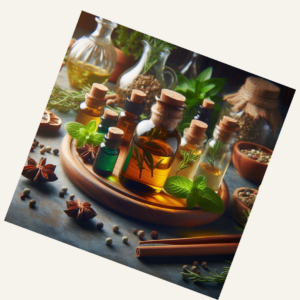A tincture is a concentrated liquid extract made from plant material, typically herbs or mushrooms, that has been soaked in alcohol or glycerin. The alcohol or glycerin serves as a solvent that extracts the active compounds from the plant material, resulting in a potent liquid that captures the herb’s medicinal properties. Tinctures are often used in herbal medicine as a way to deliver the therapeutic benefits of plants in a concentrated form.
Tinctures have been used for centuries for a variety of health and wellness purposes, as they offer an easy and effective way to use herbs for healing, supporting specific bodily functions, or balancing energy.
Benefits of Using Tinctures:
- Convenient and Potent: Tinctures provide a concentrated form of herbs, making it easier to get the desired medicinal effects without having to consume large quantities of the plant itself.
- Long Shelf Life: Because tinctures are made with alcohol, they have a long shelf life, often lasting for years without losing potency when stored properly.
- Rapid Absorption: Since tinctures are liquid, they are quickly absorbed by the body, making them an efficient way to deliver herbal compounds into the bloodstream.
- Precise Dosage: Tinctures allow for more precise dosing, which is especially helpful for those looking for specific therapeutic effects.
How Tinctures Are Made:
The most common method for making tinctures involves soaking plant material (such as dried herbs, roots, or mushrooms) in an alcohol-based solution, though vegetable glycerin or apple cider vinegar can also be used for those who avoid alcohol.
- Choosing the Herb: First, select the plant material based on its therapeutic properties. For example:
- Lavender: For relaxation and anxiety relief.
- Echinacea: For immune support.
- Ashwagandha: For stress relief and adrenal support.
- Turmeric: For inflammation and joint pain.
- Preparing the Herb: Chop or crush the plant material to release its active compounds. Dried herbs are most commonly used, though some fresh herbs can be used if properly prepared.
- Choosing the Solvent:
- Alcohol (typically vodka or brandy) is the most commonly used solvent, as it effectively extracts both water-soluble and fat-soluble compounds from the plant.
- Vegetable Glycerin is a sweet-tasting, alcohol-free option used for those who prefer to avoid alcohol. It extracts water-soluble compounds well but is generally less potent than alcohol-based tinctures.
- Infusing the Herb:
- Place the herb into a glass jar and pour the alcohol (or glycerin) over the plant material, ensuring it’s completely submerged.
- Seal the jar tightly and shake it well. Store the jar in a cool, dark place, shaking it every day or so.
- The tincture will need to steep for 8 weeks or more. During this time, the solvent extracts the active compounds from the plant.
- Straining the Tincture:
- After the steeping period, strain the plant material from the liquid using a fine mesh strainer, cheesecloth, or a coffee filter.
- Store the resulting liquid (the tincture) in a dark glass dropper bottle for easy application.
How to Use Tinctures:
- Dosage:
- The dosage of tinctures varies based on the herb and the intended therapeutic use. A general starting point is 1-2 droppers full (about 20-40 drops), 1-3 times per day.
- Follow the recommended dosage instructions provided with the tincture, as it can vary depending on the specific herb and the concentration.
- Administration:
- Under the Tongue: For faster absorption, tinctures can be taken directly under the tongue, allowing the liquid to be absorbed through the mucous membranes.
- Mixed with Water or Juice: If the tincture’s taste is strong or unpleasant, it can be mixed with water, juice, or tea to make it more palatable.
- Topical Use: Some tinctures, especially those made from herbs like calendula or chamomile, can be diluted and applied topically for skin conditions or healing wounds.
- In Food: Some tinctures, especially those made from herbs like rosemary or oregano, can be added to food as flavoring or medicinal enhancement.
- Frequency:
- Tinctures are typically taken 1-3 times a day. Start with the lowest dose and increase gradually, if necessary, based on your body’s response.
- When to Take:
- During or After Meals: For herbs that are beneficial for digestion or overall wellness, tinctures can be taken after meals.
- Before Bed: If the tincture is meant to support sleep or relaxation, such as lavender or chamomile, it’s best to take it about 30 minutes before bedtime.
Considerations and Cautions:
- Alcohol Sensitivity: Some people may need to avoid alcohol-based tinctures, especially those who are sensitive to alcohol, are pregnant, or have certain health conditions (like liver disease).
- Alcohol-Free Options: For those avoiding alcohol, tinctures made with vegetable glycerin or apple cider vinegar are suitable alternatives.
- Pregnancy and Health Conditions: Always consult with a healthcare professional before using tinctures during pregnancy or if you have any underlying health conditions.
- Taste: Tinctures can have a strong, herbal taste, so it’s important to be prepared for the flavor. Mixing them with water, juice, or tea can help mask the taste.
- Interactions with Medications: Some herbs can interact with prescription medications, so it’s important to do thorough research or consult a healthcare provider before using tinctures, especially for long-term use or if you’re taking medications for chronic conditions.
Tincture is one of the many methods of using essential oils.
